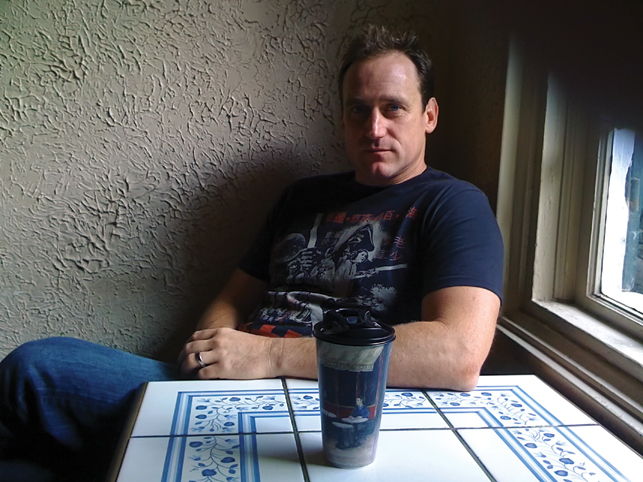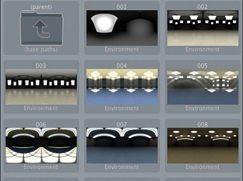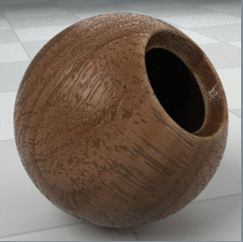Luxology has risen in profile in the design and engineering world very quickly over the last few years. This is possibly due to the growing adoption of its rendering engine, Nexus, by the likes of SolidWorks and Bentley Systems, both of which have discovered that it enables more accurate previews, quicker set-up times and rapid calculation speeds.

Brad Peebler, co-founder and CEO of Luxology
Alongside the CAD integration of its technology, Luxology’s Modo modelling, animation and rendering system has been increasingly popping up on our radar. While Modo’s background is in the digital entertainment and animation world, the last few years have seen it evolve into an end-to-end solution, making it a vital part of the designer’s and engineer’s toolkit.
Luxology have also released new resources for the Modo user interested in industrial design work. There’s the sunglasses tutorial set that shows how Modo’s sub-divisional modelling tools can be used to generate a design concept pretty damn quickly.
Then there’s the comprehensive Packaging Design and Construction Kit, which takes the core base of Modo and adds in not only standard parts and libraries for caps, but delivers a workflow that’s ideal for anyone working in structural packaging, so, helping the user avoid the ball-ache of trying to do these things in a traditional CAD modelling tool.
With all that in mind, now seemed like as good a time as any to catch up with Brad Peebler, co-founder and CEO of Luxology.
Al Dean: I wanted to start by talking about the split in your business. There’s the existing Luxology user community heavily engaged in the film and games market, then there’s the rapidly emerging business involved in product development. Do you see this as a distinct split or is there a cross pollination and lessons that can be transferred between the two?
Brad Peebler: Honestly, we planned for this “split” from the very beginning. Our vision has always been that there are uses for high quality “entertainment style” 3D technology well beyond TV/film and games. Our vision in founding Luxology was that if we could provide very high-quality technology but make it easier to learn and faster to produce, we could grow the market.
The barrier to entry for 3D graphics was no longer the cost of the hardware and software but the cost of human time to get from blank screen to final image. If we could lower that barrier we would attract new users from other markets such as CAD, design, photography, etc. The fact that you can see our product in all of these markets is a strong sign that our initial vision was correct and that our strategy is working. Huzzah!
The Pixar Subdivision Surfaces implementation in Modo 501 is a really interesting example of how we continue to drive the convergence of Design Viz /CAD and Media and Entertainment markets via technology. We’ve implemented this geometry type in Modo to assist with what we call “structured organics”- the sort of flowing mesh that can be described as hard surface and organic at the same time.
You can sculpt these meshes with the flexibility and artistic feel of clay and you can also have very specific control over edge creasing. You can push and pull them into a character or finesse them into a concept car. The PSUB (Pixar SubD), as we call them, is a technology that comes directly from the top of the film industry (thanks to a technology transfer between Luxology and Pixar) and yet it is one of the favourite features of Modo 501 among our clients who do industrial design.
AD: Your profile got a boost with SolidWorks taking on the Nexus engine for its PhotoView 360. How has that changed your business?
BP: It’s been very positive, of course. The great thing about the arrangement with SolidWorks is that it goes deeper than just the technology. We genuinely enjoy working with their team and, more recently, we’ve even done some co-marketing efforts on their “Drive to Design” project, which was dreamt up by SolidWorks’ Mark Biasotti.
We also have a similar arrangement with Bentley Systems so, as it stands, the Luxology render layer is now directly integrated into two of the most popular CAD applications in the world. Would you believe that this was also part of our initial plan? It was. I have to admit we know we were very lucky to link up with Bentley and SolidWorks right out of the gates.
When we began development of our internal technology platform, Nexus, we had in mind that if it were layered in architecture we could OEM [original equipment manufacturers] portions of it to other companies to give us scale well beyond our traditional Media and Entertainment space. So, aside from trying to grow the market by making a 3D application that was faster to use and high quality, we also knew we could scale much more effectively if we could license technology to partners that were domain experts in areas where we were not.
We really had three major components to our initial business plan. Modo represents the first component and was also critical as a means to validate our Nexus technology platform when we pitched it to other companies. Modo led to success in phase two, OEM technology. This OEM strategy had two approaches. One was to leverage Nexus to create a custom application for a partner (Photoview 360) and the other was to enable partners to integrate our technology directly in their applications (Microstation and Solidworks 2011). Clearly, we have validated Nexus now in both methods, which is significant.
AD: Do you see different challenges between your CGI/DCC customers and your design customers? Or are the lines a little more blurred?
BP: There are many requirements between the two groups that are pretty much identical. Everyone wants to render faster and everyone wants software to be more intuitive and fun to use. Both groups also care about a well designed UI and attention to details in workflow. If you forget for a moment that at the end of the day one group is making pictures and the other is making products, all of our customers are designers of a sort.
Of course, there are very real and technical differences that arise from the pipeline in which our technology is being applied. In the DCC realm, we have to support very different data than in the design world.
There is also a rapidly growing set of users in both groups who are finding Modo to be a complete pipeline for all their needs. In the DCC world, we have users who deliver final products directly from Modo. In the design world, we have customers who are sending Modo data out to be printed for rapid prototyping.
The lines between CAD software and visualization software are blurring rapidly and this is exactly where we want to be. If you take a look at our recently announced Package Design and Construction Kit (PACK), you will find a system that leverages our fast modelling tools, smart content and visualisation chops to deliver a method for design exploration and iteration for package designers. I think people will be intrigued at our recent venture.
AD: For those who missed your presentation on Cloud Computing at last year’s Congress on the Future of Engineering Software (COFES), could you talk a little bit about that, giving us a run down of the points you were talking about and where you think the whole cloud thing is headed? Is it a good thing, a bad thing or not a thing at all?
BP: As discussed at COFES, I throw up a little every time I am forced to say “The Cloud.” Let me preface this by saying that I think the amount of compute power we have access to via the internet is AMAZING. It is truly phenomenal but… using compute resources across a network is not a new concept. Renting those resources from someone else is also not a new concept.
Why we have to call it “The Cloud” and pretend it is magical is baffling to me. Okay, actually it isn’t baffling and I know exactly why we have to do that: marketing. I suppose I’d rather just cut through the crap and call it what it is so customers can actually understand the benefits and power as well as the limitations. This will ensure that we leverage this awesome power responsibly instead of simply to catch some revenue from the mad rush of uneducated Cloud Lovers.
My presentation at COFES was “Cloud-enabled,” which is to say I was driving remote visualisation servers from a think client (iPad). The real point of my presentation was that we have to stop simply trying to eat each other’s customers and find ways to grow the industry as a whole. As an industry, we have an amazing resource that is so disgustingly under-utilised it makes me want to weep like a schoolgirl. We are 3D! That’s right. 3D! What I am trying to say is that we are horrible at promoting our content and, as we’ve heard a million times, content is king, right? Right!
Have you ever gone to a website that sells 3D content? It’s mostly “fairy porn” or a wild hodge podge of random 3D models that are never in the format you actually want them in. Further, our content is only relevant to the people who use 3D applications, which means the total available market is implicitly tiny. Let’s compare this to another content: 2D. We are obviously better than 2D because we have an extra D. Duh. And yet, those cretins making 2D content are making cash hand over fist! Did you know the stock photography market is a multi-billion dollar industry? And they have less D!
In my opinion, and this was my point at COFES, there are many ways that our industry can grow by looking at other industries and proving that we are a superset of the incumbent tech. But this means we have to pause from the constant internal battles between the 3D vendors and think bigger. This, in turn, can be the rising tide that lifts all boats.
My demo at COFES showed how Cloud-enabled 3D content has the potential to crush today’s 2D stock photography but first we have to show that 3D has the same visual quality as photography. People don’t buy real-time 3D assets because they generally do not look compelling. We know 3D can be photographic and we also know 3D is more flexible than 2D. The challenge is that our industry has erred on the side of “real-time” at the expense of image quality. Coupling our advanced technology with the power of cloud computing, we can deliver more compelling and flexible content to consumers.
Drive a demand for content and you end up driving a demand for tools, which ultimately opens up the market.
Is the Cloud a good thing? Yes, it surely is. Will it replace our desktop any time soon? I really don’t think so. Do you want your design tool to work at the speed of your wi-fi connection? Me neither. What I would really love is for everyone to fully understand just what the Cloud is and what it isn’t. Companies should be focusing on the issues we can solve for our customers today rather than cramming things onto the Cloud to capitalise on the buzzword du jour.
AD: What about the Luxology user community and your participation in it.? There are many discussing the role of social media in the technology world and it strikes me that your Modcast is something that actually gives something back to the user.
BP: I’d like to say that I’m a social networking genius but the fact is that we simply do what comes naturally. We engage our users because they are smart, mature people and we can learn a lot from them. We speak the truth to our users because that is the path to long term success. You can reap short term gains via marketing B.S. but eventually that will come back to haunt you. We were practicing “social media” before there was a name for it.
When we founded the company, the first thing we did was put up a website where artists and designers could share news, assets and just chat about the industry. We’ve always allowed people to talk openly about other applications and to challenge us publicly on our forums because we know that allowing people to communicate freely means they will stick around and continue to share their views. Companies are often short-sighted and feel that any challenge to their product, company or philosophy should be edited away so a new customer doesn’t see it.
The fact is, you can’t stop this level of communication and if you don’t allow it on your site, your users will just go somewhere else to talk and we’d rather keep our customers close to us.
AD: 3DTVs: The future of entertainment or just a bunch of idjits sitting at home in crappy looking spectacles?
BP: I’m not a fan of gimmicky technology but I have to admit that I am a fan of stereoscopic 3D, when done correctly. I’m not really sure how I feel about “3D” TVs just yet. I suppose my current feeling is that stereoscopic 3D is really best when it is an immersive experience, which really requires a larger screen like those in movie theatres.
In fact, the best stereoscopic experience I’ve had was in an IMAX 3D dome. The trouble is that the effect of stereoscopic falls apart at the edge of the screen so the more of your field of view that is filled by the screen, the better. IMAX can really deliver a nearly immersive experience. Movie theatres, not as much, but still pretty fun. And TV, for the moment, feels a bit like looking into a fish tank rather than experiencing the true effect. I certainly won’t be running out to pick up a “3D-enabled” TV set anytime soon.
AD: Final three things. FIrst is that I’ve got a new German word for Bob “Gabelstaplerführerschein” – Pass it on.
BP: Done. I’m not going to ask.
AD: 2: Nikon kicks the pants out of Canon.
BP: Sod off.
AD: 3: Who kicks it harder: Chuck D or Rakim?
BP: I’m afraid I’m going to have to go with Chuck D.
AD: Can’t argue with that B. Thanks man, see you soon.

Al Dean talks to Brad Peebler, co-founder and CEO of Luxology









